
FILM AS ART CLASS: RAGING BULL
“Art is a lie that tells the truth.”
– Picasso.
It’s a great way to describe the art of filmmaking. It is not only a great lie, it is the perfect lie.
Films are the only art form in which you can have the same physical reaction or response as those portrayed on screen. Our brain chemistry will trigger fight or flight, sympathy, sadness, fear, relief, and so on. Other art forms really can’t do that in the same way as films. Every frame of a film affects us, whether we’re aware of it or not. We see, we interpret, we respond.
Films are a completely unique art form. It is not like music, but uses it and can be melodic in structure.
It is not theater, but uses acting and staging.
It is not literature, but it uses writing and story telling.
It is not dance, but can use dance like movements by camera or actor.
It is not a drawing, painting, or still photography but uses images to convey its message. It shares so many elements of these other art forms, but is its own unique art form.
So let’s watch RAGING BULL and then…
RAGING BULL

Is this film formalistic or realistic?
Formalism: defined as marked attention to arrangement, style, or artistic means.
A formalistic film would be stylistically bold or dynamic. A formalistic director would concentrate on expressing their vision in an unrealistic way to evoke an emotion.
A realistic film attempts to preserve the illusion that the viewed world is unmanipulated, an objective mirror of the actual world.
So is this film formalistic or realistic?
Both, in my opinion. Overall, I would characterize it as interpreted realism.
Scorsese has taken “reality” to another level in RAGING BULL. The fight scenes are operatic. They are stylized and brutal, yet extremely lyrical. These scenes are formalistic, not real. The rest of the film, those scenes outside the ring, are much more naturalistic. But, we don’t see in black and white, we don’t hear animal noises, time does not speed up or slow down, and we do not view the world in freeze frames. It is meant to evoke an emotion. It interprets reality in a way that has never been done before.
What do we typically see in sports’ films? How are they constructed? What happens at the end of the film?
Scorsese has reversed and deconstructed the sports’ film. Typically in this genre the hero/protagonist has his or her big victory at the end, like The Fighter, the Rocky films, Champion (Kirk Douglas), or Cinderella Man, etc. Sports’ films in general, end with the big win, the big game, the home run.
In addition, boxing films are also typically cut to illustrate how fast you can punch and move. Which is what boxing is about. By shooting in close up, slow motion, utilizing freeze frames, swish pans and angles in a unique way, Scorsese comments on how rigorously violent this sport is. It is the most brutal portrayal of boxing in films, to date.
In addition, boxing films are also cut for excitement. Scorsese and Thelma Schoonmaker have cut it to get inside the boxer’s mind. They connect the shots to give us an emotional response. To feel it. To identify with it. The camera devices, the sound, the editing is glued to the material and emotion of the film for the express purpose of impacting the audience.
In order to control the environment, the fight scenes were shot on a sound stage. The ring size, lighting choices and design of shots were carefully choreographed to reflect Jake’s emotional state in each sequence.
Scorsese shoots inside the ring one camera at a time. He changed lighting, and even the size of the ring, to suit Jakes emotional state of mind.
Two scenes were shot mostly from outside the ring. What happens to us when he does that? We are relegated to the role of observers, not participants. When he throws the fight with Fox we are outside the ring and there is nothing we can do emotionally. When he’s playing possum in the Dauthuille fight, we start outside the ropes then move inside as soon as Jake starts to hit Dauthuille. He combines both styles in the Dauthuille fight to emotionally move us from impotent observer to a willing cheerleader.
All of the fight scenes are Operatic. Slow then fast. Severe angles. Operatic not only in how they are shot, but what we hear. Animal and bird noises as well as the light bulb flashes and popping sounds. They are shot inside the ring and in close up. Jake is often shot from a low angle, a visual cue into his superiority and power. He looks down at us and his opponents. Opponents on the other hand are often shot from a high angle, illustrating their inferior position.
Every fight has a different style and was choreographed as a dance e.g. mambo, tango, foxtrot, etc. His use of sound is extremely effective. In between rounds, we hear Jake’s corner as we see his opponent sitting in their corner. Jake’s corner staff is always concerned with the opponent and so are we. He’s watching the opponent as he listens to them and we are always connected to Jake even when we don't see him. Even though Scorsese interprets the emotional context of the fights, they are accurately choreographed because of the actual films of Jake’s fights from that time.
Scorsese was greatly influenced by the 1948 Michael Powell film, THE RED SHOES. He applied many similar elements to the fight scenes that he learned from this film. In THE RED SHOES, Powell wanted to illustrate to us the spirit of the dance, as Scorsese wants us to get inside the boxing ring with Jake.
In editing, Eisenstein’s method of cutting, particularly the baby carriage scene in BATLESHIP POTEMKIN, was a model for rapid-fire emotionally brutal fight sequences.
So. Why is this film significant?
There are eight fight scenes and they appear to take up much of the film, however the screen time totals approximately 11 minutes. The conflict in Jake LaMotta’s personal life occupies the other 118 minutes. It is not a boxing film; it is a film about a man who boxes.
What this film does is pose the question, “How can we expect a person who beats people up and is beaten up for a living be a gentleman outside the ring?” Let’s look at each of the following scenes that I’ve chosen and let’s discuss them.
Title Sequence

Scorsese does not waste any time getting us into the film. It is like a prelude, an announcement of what is to come rather than a more pedestrian opening scene. Scorsese has expressed so much in this non-dialog first moment under the title sequence.
What does this opening shot tell you?
It is 3 minutes long and is in black and white. The only color is the blood red title RAGING BULL.
It is one shot, one set up.
In slow motion, we see a man all alone shadow boxing, dancing, trotting in the smoke filled ring and arena. He is warming up for his fight, furiously punching at the air, fighting an invisible opponent in some hellish dreamlike place.
We cannot see his face, it is hidden in the monk-like hood and he is in a leopard print robe. The music is haunting, funereal, and melancholy. "Intermezzo" from Cavalleria Rusticana by Pietro Mascagni.
People are along the side of the ring watching him. It’s a very wide shot so we are observers, tourists, voyeurs in this opening.
It is a religious, almost spiritual environment in which he prepares for his ultimate battles – in the location of his only reality, the confined boundaries of the ring.
Does this title sequence/opening shot illustrate a possible theme?
The ring represents life. The only foe you have is yourself. The only person in your way is yourself.
Does it let us know this will be a lonely journey for this fighter?
Does it cue us into the religious imagery that is to follow? The religious journey?
Scene 26 97-minute mark
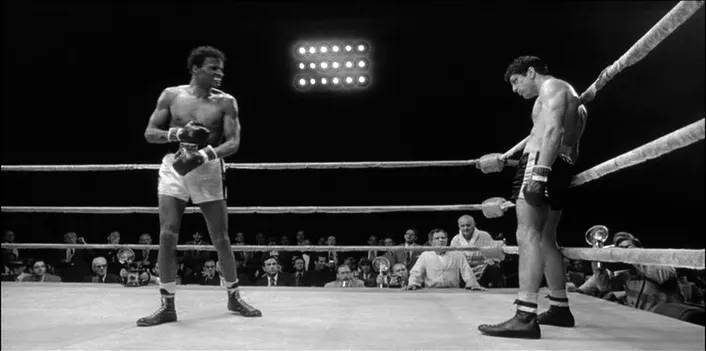
In other boxing and in films in general, there is the tendency to show the audiences’ reaction or the other actors’ reaction. The director is trying to give us a cue, because they don’t trust us as audience members.
Being beaten and pounded in the ring serves as his penance and absolution. Fighting is not only a way to address his rage and guilt, but it is also a religious experience for him.
Scorsese uses real commentary from the television broadcast to narrate the action and only does that here which makes it even more powerful.
The look of this fight is a pit of hell. Smoky and shimmery hot. Small and compact ring.
Scorsese compresses and expands time. Time is fluid. Time only exists in our own mind. He uses slow motion, and then speeds it up.
When Robinson goes in for the kill. No sound except for ambient sound that has been enhanced. It’s ethereal. Lights dim in the ring. Then explosion. There is a use of silence throughout the film.
Scorsese’s use of sound: Animal noises. Bird noises. Elephant trumpeting and a horse shuttering. Variable speeds of sound. The screeching sound of dry ice on glass. The sound of flashbulbs popping.
He cuts away from the fight, this is called an irrational cut. Irrational cuts only work if something significant comes from them. He shows us, one, that his brother stills cares, and two, to give us information. That he had to knock him out. Since he cannot knock him out he makes a statement. What does the announcer say?
Religious imagery, religious ICONOGRAPHY is used throughout the film, but it is most evident here. Iconography is the branch of art history, which studies the identification, description, and the interpretation of the content of images. The word iconography literally means "image writing"
When he is in his corner it appears as if he were lying down. He is like a bloody corpse being washed. Like the body of Christ being washed before burial. He is awash in blood. Two things happening, first being bathed and second awash in blood.
The application of Vaseline is a common boxing practice, but here it looks like he is being given last rights.
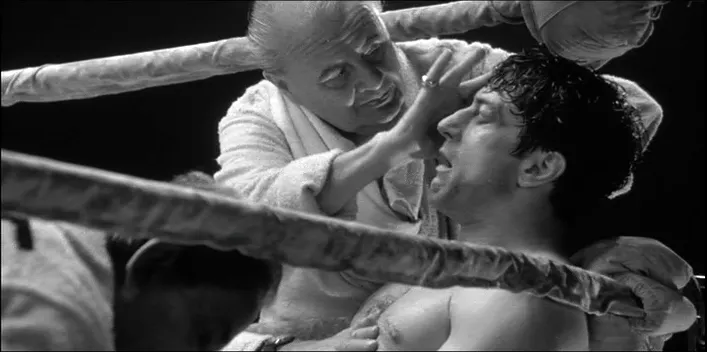
He receives his mouthpiece as if he is given a communion wafer during Holy Communion.
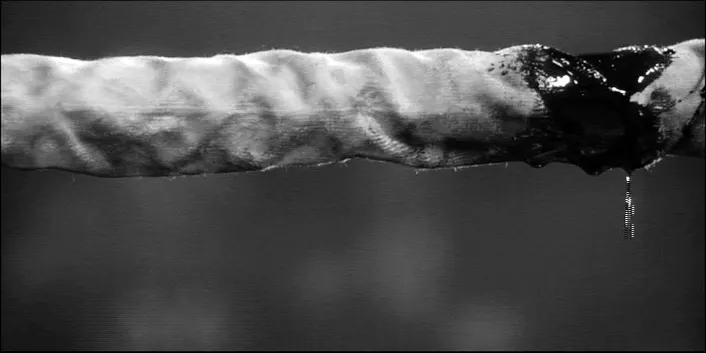
Blood dripping from the ring rope. This is a SIGNIFIER. A signifier is a sound, word or in this case an image that has meaning distinct from its form. It is just blood on a rope, however as a signifier, it can mean that he spent every last drop of blood, or he left all his blood in the ring or blood dripping from his cross. What do you think it means?
Signifiers can also be a color, a look by an actor, or even a camera angle. As we mentioned earlier, Scorsese shoots Jake from a low angle to cue us into his power. Opponents on the other hand are often shot from a high angle, illustrating an inferior position. These are also signifiers.
The images are religiously ritualistic, a metaphor for Jake's defeat and crucifixion at the hands of Sugar Ray Robinson.
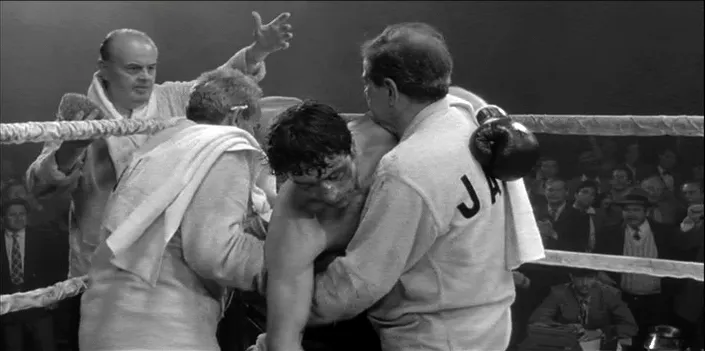
Scene 22 70-minute mark

The Cerdan Championship fight. A steady cam leads, then follows and gets up onto a cherry picker crane all in one shot. This is called the long take. This fight scene is the only time we see him walking into the ring. Other fight scenes start in the middle of the action. In this scene, he is like a Roman Gladiator entering the Coliseum.
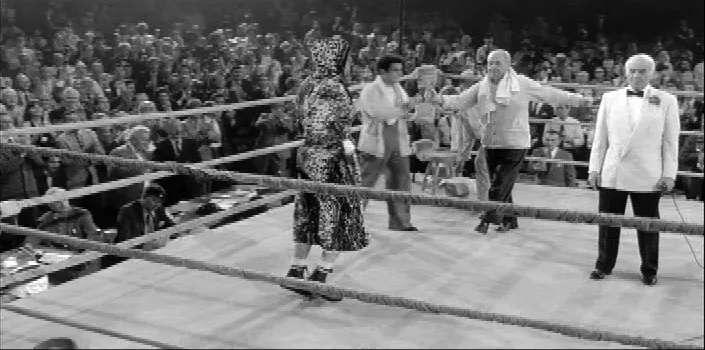
It is Jake’s moment. It is everything he wants, and in other fight or sports films it would be the climax.
Scene 10 31-minute mark
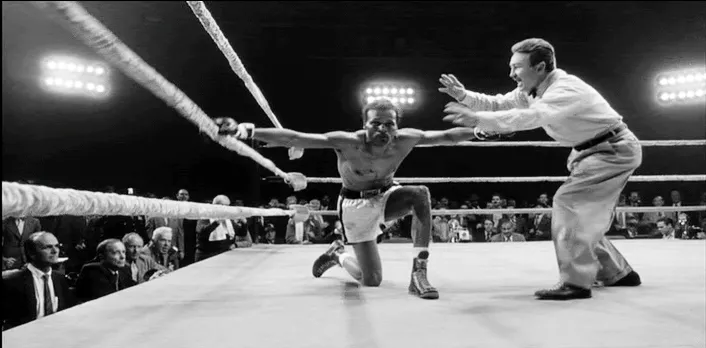
This is the second fight sequence, the first Robinson fight in the film. The ring is large and it is very bright evoking a much more confident mood.
Unlike the first fight sequence, we have left any notion of realism behind us. Scorsese begins to use the swish pan to orient and disorient us, freeze frames and slow motion, and introduces odd and ethereal sounds moving us into a more formalistic, or interpreted reality of filmmaking. It is becoming more about Jake’s emotional internal state as opposed to a vision of reality.
It is a big victory for Jake and we feel it. We’re also clued into the fact that he is at the top of his game, all of his senses focused on this moment in time.
Scene 12 38-minute mark
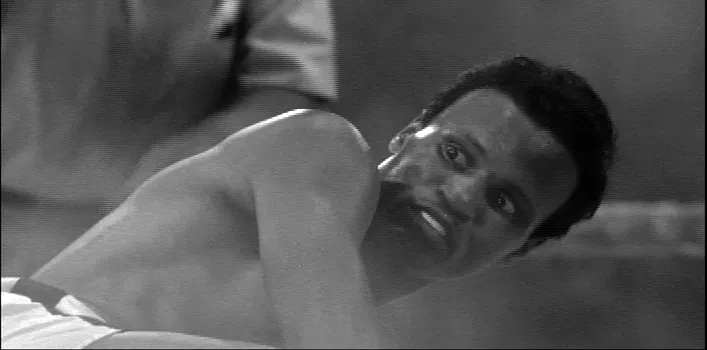
When he loses, it’s smoky, hot, dark and small. Scorsese has done some things here visually and auditorilly to cue us into what Jake is feeling. Anger, focus, paranoia, desperation, etc. Long lenses, with gas flames underneath, make the heat waves that signal this pit of hell.
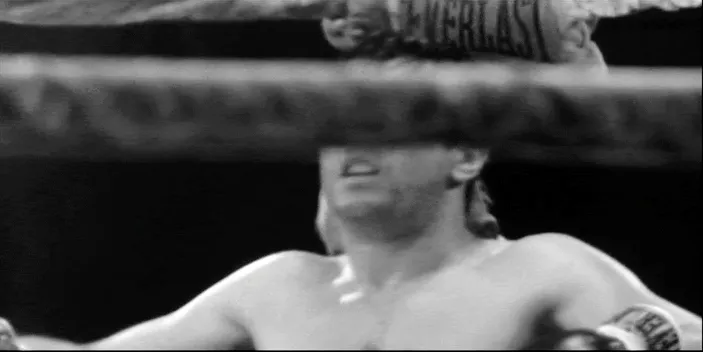
His eyes covered by the ring rope when he sits down.
It was not until I was asked to discuss this film that I realized I had taken a page from Scorsese’s filmmaking in my own feature, ALONG FOR THE RIDE. I too, covered up someone’s eyes. It was Jake Cowen’s eyes in the back of the car that his two sons are driving. I was told that this is just not done, that it’s not right. I felt it made a wonderful statement about how their father never watched over them. How he abandoned them. That he covered his eyes to their pain.

Scene 13 41-minute mark
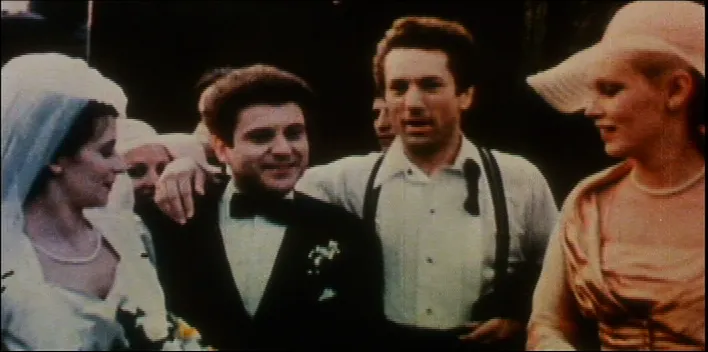
The home movies are in color. A movie within a movie. Washed out color, scratchy, choppy. The film we are watching in black and white is real life. The color home movies are a representation of that. He has flipped the normal convention of showing real life in color and black and white being the representation or dream. He intercuts Jake’s fights in stills and extreme slow motion as a counterpoint to this view of his life outside the ring.
Scene 15 50-minute mark
To get us into Jake’s mind Scorsese judiciously uses slow motion. We can see his paranoia when he watches Vicky.
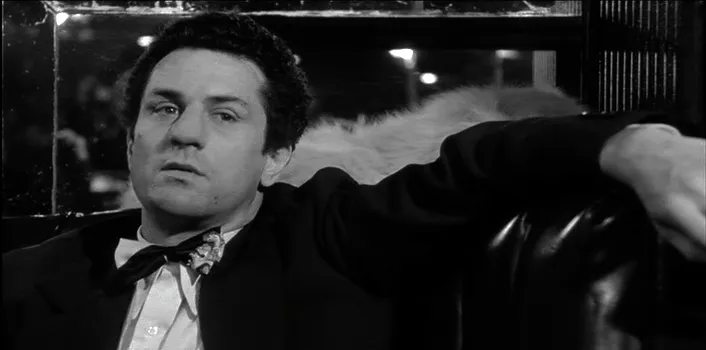
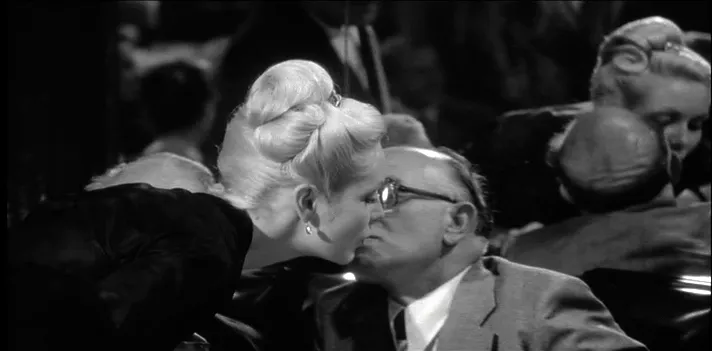
Scene 24 90-minute mark
Jake beats Joey in his own home in front of his wife and kids. Being beaten is bad enough, but he is further humiliated by where it takes place and the people who witness it. This is the second time that Jake beats up Joey. The first time is in the gym in front of Joey's mobster acquaintances.
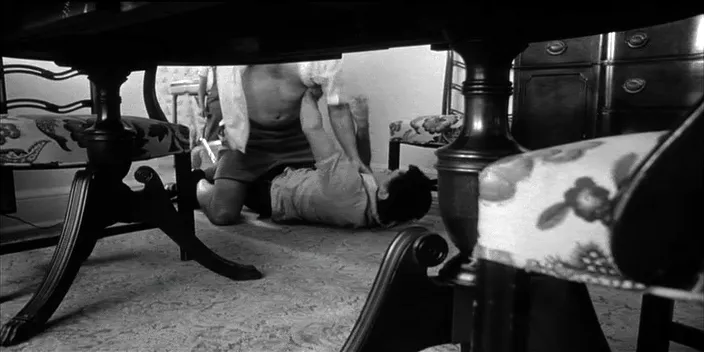
This could have been shot anywhere, but it wasn’t. Could have been in a bar, on the street, etc., but Scorsese has chosen to stage it in Joey's home.
Filmmakers have an infinite amount of choices as to where they can shoot a scene. The location of the scene should have meaning. What else does this location say?
Scene 34 119-minute mark
Jake corners Joey in a parking lot. The hug.
What’s going on here? Physically and emotionally?
It’s primarily from the back. Scorsese resists the temptation of classic American cinema, to put the camera in a position to see DeNiro’s face.

That is called SUTURING. To shoot a reverse angle. Filmmakers often cut away from emotion. They are scared of it. This cutting back and forth is suturing. Flipping the shot onto the other actor.
He shoots it from the back, which changes the emotion and makes it more uncomfortable for us. You release the tension when you cut. He is allowing us as an audience to make our own determination of the emotion. We have to make our own decision on Jake’s emotional state. Shots are energy. You’re releasing the energy when you cut. That’s why we get so uncomfortable with a shot that is held very long.
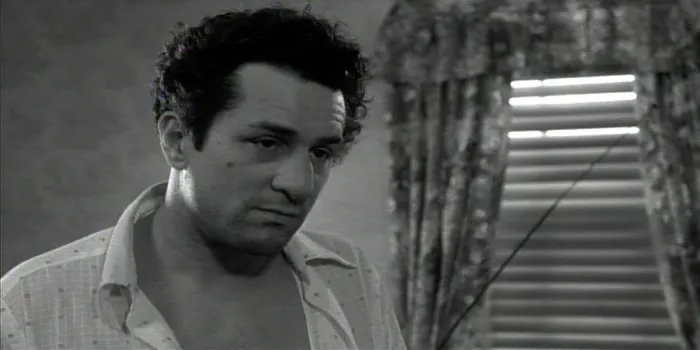
Scorsese holds Jake’s look throughout the film and with all of his characters. He holds on the actors, which is very risky. He trusts his actors and they trust him. But more importantly, he trusts us, the viewers, to understand what is going on in these actors’ heads and doesn’t cut away from the emotion.
Closing
Our time is about up and there is so much more we could discuss. This film is a brilliant balance of realism and heightened expressionistic effects. It would be wise for every new and emerging filmmaker to watch this film over and over again. Thanks for allowing me to share this film and my thoughts with you today.